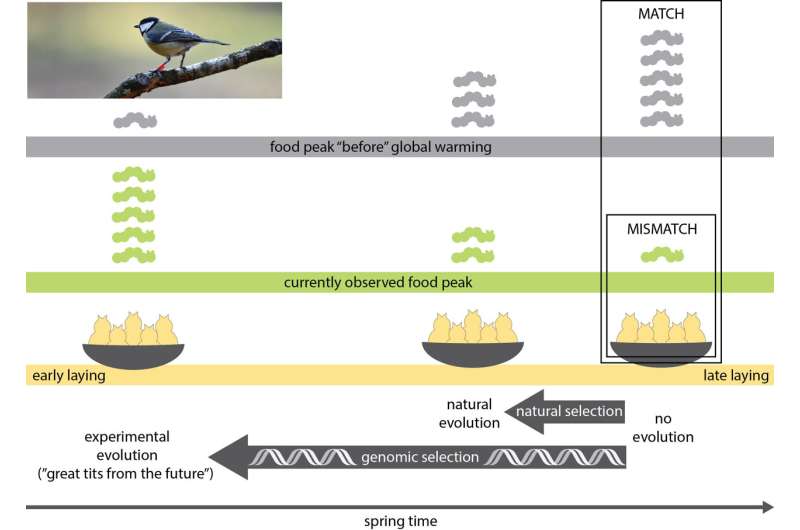Birds need to adapt to climate change, but evolution is a slow process. Model species such as the great tit are an indispensable yardstick for our ability to predict the impact of climate change on nature. Using innovative methods, a team from the Netherlands Institute of Ecology (NIOO-KNAW) took a sneak peek into the birds’ future.
Can species keep up with the climate change yet to come? How fast can they adapt? We need to understand this before we can properly predict the effects of climate change on nature at large. “It’s important to know,” stresses research leader Marcel Visser, “because climate change and evolution need to keep a relatively even pace for species to keep up.”
Back to the future
“That’s why we set out to study great tits from the future,” explains Visser. “In the coming decades, natural selection will produce birds with a particular genetic make-up. To predict the extent to which these birds can respond to natural selection, we sped up evolution through artificial selection of genetically early and late birds in aviaries. We then took the eggs to our long-term population in De Hoge Veluwe national park, to see how their offspring did compared to wild great tits.”
“In the forest, the earliest birds did in fact lay their eggs earlier than great tits selected for laying eggs late,” adds researcher Melanie Lindner. “So we were able to successfully select them for laying eggs early or late in spring. But the earliest birds didn’t lay their eggs significantly earlier than the wild great tits breeding in the forest, while the ones we selected for laying their eggs late, did have a significantly later lay date.”
In the end, these early birds didn’t breed any more successfully than the ones in the wild. “Genetic adaptation towards early lay dates turns out to be an extremely slow process.” The results of the study have been published in the journal Science Advances, with Lindner as first author.

How does the selection of early, or late, birds take place? An overview. © Melanie Lindner & Marcel Visser/NIOO-KNAW
Ecological relationship problems
Climate change is giving insectivorous songbirds such as the great tit a bad case of ecological relationship problems. Their timing no longer matches that of the insects their young feed on: the “caterpillar peak” in the forest and the moment young great tits hatch no longer coincide. Consequently, they miss out on the biggest, juiciest caterpillars—with the most nutritious proteins. Changing their timing could be a solution, but until now it remained unclear how much earlier the birds could actually lay their eggs.
So what will happen to great tits in the coming decade? “What we’re seeing now is that climate change is simply going too fast for them,” says Marcel Visser. “They won’t be able to adapt sufficiently. In the bleakest climate scenarios, in particular, the birds will fall behind more and more.” As a result, the number of great tits fledging will decline.
Camouflage
So why aren’t we witnessing a decline in population numbers of the great tit yet at the moment? “Right now, the population effects are buffered by density-dependent processes,” says Visser. The real impact of climate change is currently being ‘camouflaged’: out of every ten chicks, eight or nine would normally die in the first year as a result of predation, disease, food shortages, competition or just bad luck. But if three of them die before fledging because of climate change, the chances of the remaining seven will improve. There’ll be more food to go around, and less competition. “But there’s a limit.”
“There’s also a great deal of variation from year to year in terms of the weather, which makes it harder to measure the impact on the birds in the field. In the years of the study, the mismatch between wild great tits and their food—the caterpillars of the winter moth—happened to be surprisingly small.”
So what else do we need to find out? Visser has some suggestions: “Now that we have looked at the impact of climate change on the relatively straightforward food chain of oak tree, winter moth and great tit, it’s time to see if we can include a larger number of the species that together make up a food network. Like the entire Veluwe for instance.”
That’s precisely one of the goals of the large LTER-LIFE program, which is about to start this July: Developing ‘digital twins’ of ecosystems to help predict how global change affects nature. And the Veluwe natural area will be the first case.
More information:
Melanie Lindner et al, Genotypes selected for early and late avian lay date differ in their phenotype, but not fitness, in the wild, Science Advances (2023). DOI: 10.1126/sciadv.ade6350
Provided by
Netherlands Institute of Ecology
Citation:
Researchers evaluate how birds can respond to natural selection to keep pace with climate change (2023, June 30)



